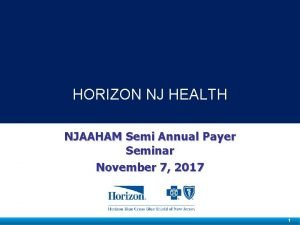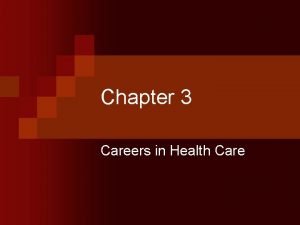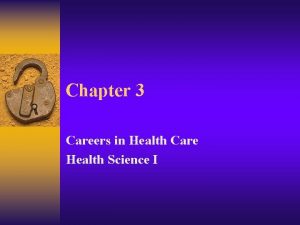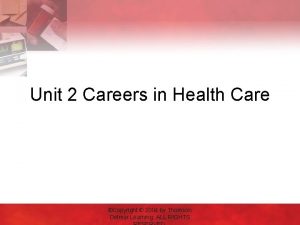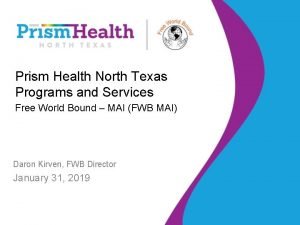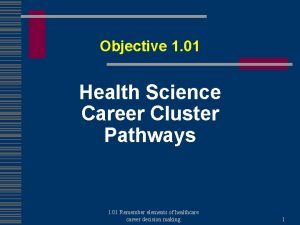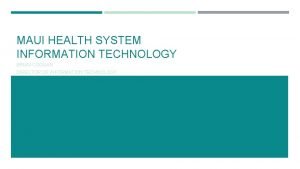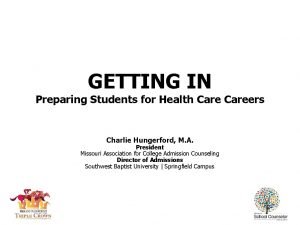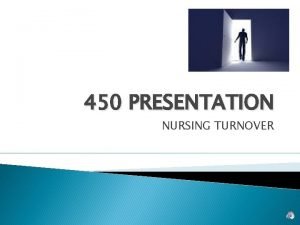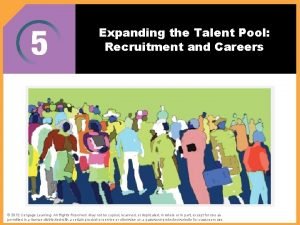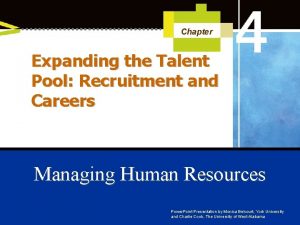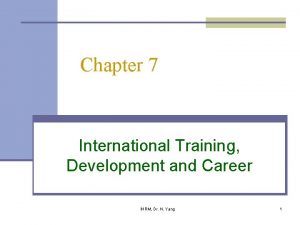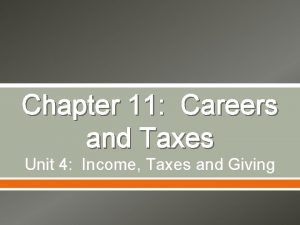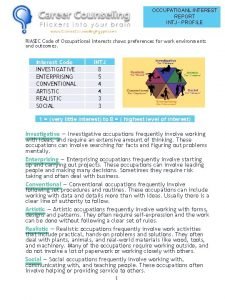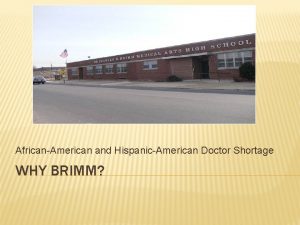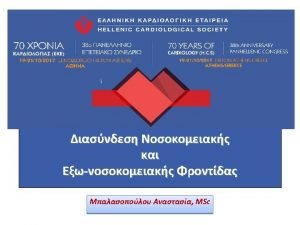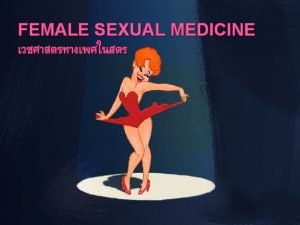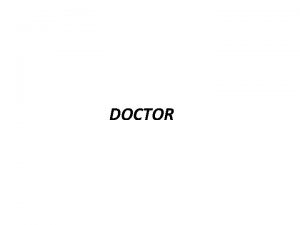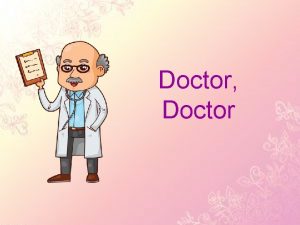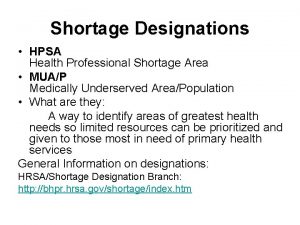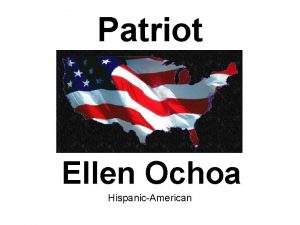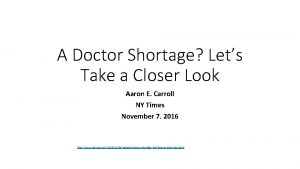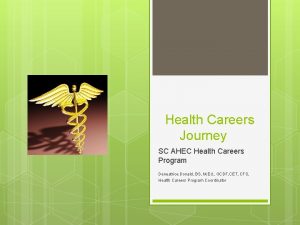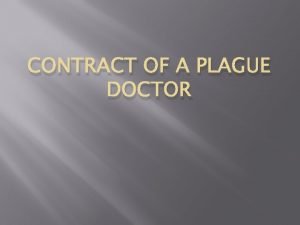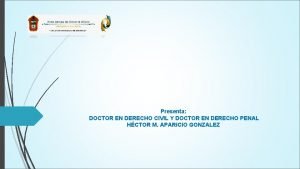AfricanAmerican and HispanicAmerican Doctor Shortage Health Careers Considered































































- Slides: 63

African-American and Hispanic-American Doctor Shortage Health Careers Considered Best Jobs and Opportunities Inequality in Health care Access and Delivery WHY BRIMM?

THE 25 BEST JOBS OF 2019 (US NEWS AND WORLD REPORT) � Health care jobs dominate the list: � Health care jobs require years of higher education. But workers willing and able to make that investment see it pay dividends in the form of high salaries and ample opportunities. Plus, experts predict there will be great demand for nurses, physicians and other medical practitioners in the years to come.

RATING THE BEST JOBS � Based on � Salary � Employment rate (unemployment rate) � Growth rate/job prospects � Stress level � Work/life balance

THE LIST 23. Speech Language Pathologist ($76, 610) � 22. Podiatrist ($127, 740) � 21. Clinical Lab Technologist ($51, 770) � 20. Physical Therapist ($ 86, 850) � 19. Registered Nurse ($70, 000) � 16. Nurse Midwife ($100, 500) � 14. Surgeon ($+208, 000) � 14. tie— Anesthesiologist ($+208, 000) � 13. Occupational Therapist ($83, 200) � 9. tie---Physician ($192, 930) �

THE LIST 9. Prosthodontist ($182, 150) � 9. Oral/Maxillofacial Surgeon ($+208, 000) � 9. Ob/Gyn ($+208, 000) � 8. Pediatrician ($172, 650) � 7. Nurse Practitioner ($103, 880 � 5. Nurse Anesthetist ($165, 120) � 5. Tie---Orthodontist ($+208, 000) � 4. Dentist ($151, 440) � 3. Physician Assistant ($104, 860) � 1. Software Developer ($101, 700) �

WHY BRIMM? (2000) � � � African Americans make up 13% of U. S. population African Americans make up 4. 4% of all U. S. physicians and surgeons Proportion of racial/ethnic minorities in U. S. is increasing, but representation in medical schools is not

UPDATED STATISTICS: BETTER? � In 2013, out of the total U. S. MD active physicians, 4. 1% were Black or African American, 4. 4% were Hispanic or Latino, 11. 7% were Asian. The percentage of black or African-American women physicians (54. 7%) was greater than that of men (45. 3%) of the same racial and ethnic group. However, men comprised a greater percentage of physicians than women across Asian (56. 4%), American Indian or Alaska Native (58. 1%), Hispanic or Latino (59. 0%), and white (65. 2%) racial and ethnic groups.

� “Research indicates that diversity in the physician workforce impacts the quality of care received by patients. ” (2013) AAMC � http: //www. msn. com/en-us/health/wellness/black -mens-health-initiative-aims-to-end-disparities-in -dc-supernumberfortheculture/ar-AAH 9 c. Sb � The secret to keeping black men healthy, maybe black doctors? ---NY Times 08/21/2018

BLACK MEN IN WHITE COATS � Black Men in White Coats

POPULATION BY RACE & HISPANIC ORIGIN: UNITED STATES, 2000 & PROJECTED 2050 Source: U. S. Census Bureau, May 2001

Percent of population Census 2000, population Percent of population 100. 0% 281, 421, 906 100. 0% 196, 817, 552 63. 7 211, 460, 626 75. 1 Black or African American 37, 685, 848 12. 2 34, 658, 190 12. 3 American Indian and Alaska Native 2, 247, 098 . 7 2, 475, 956 0. 9 14, 465, 124 4. 7 10, 242, 998 3. 6 481, 576 0. 15 398, 835 0. 1 5, 966, 481 1. 9 6, 826, 228 2. 4 604, 265 . 2 15, 359, 073 5. 5 16. 3 35, 305, 818 12. 5 Race and Hispanic/Latino origin Total Population Single race White Asian Native Hawaiian and other Pacific Islander Two or more races Some other race Hispanic or Latino Census 2010, population 308, 745, 538 50, 477, 594

HISPANIC DOCTOR SHORTAGE � 14. 2% of U. S is Latino (2000) � 6. 4% of U. S. doctors are Hispanic (2000) � Hispanic fastest growing ethnic group � Similar growth is not evident in medical schools � In 2007, the number of accepted Latino students to medical school was down 4% from 2006

UPDATE: IMPROVEMENT? ? � Latinos are one of the fastest growing ethnic groups in the United States, with their numbers having risen 243 percent since 1980. Yet the number of Latino physicians per 100, 000 Latinos has declined by 22 percent during that period, according to new research. � In 1980, there were 135 Latino physicians for every 100, 000 Latinos in the U. S. ; by 2010, that figure had dropped to just 105 per 100, 000

HISPANIC DOCTOR SHORTAGE � Hispanic Physician Shortage � Shortage of Latino Physicians

UPDATED STATISTICS: BETTER? � In 2013, out of the total U. S. MD active physicians, 4. 1% were Black or African American, 4. 4% were Hispanic or Latino, 11. 7% were Asian. The percentage of black or African-American women physicians (54. 7%) was greater than that of men (45. 3%) of the same racial and ethnic group. However, men comprised a greater percentage of physicians than women across Asian (56. 4%), American Indian or Alaska Native (58. 1%), Hispanic or Latino (59. 0%), and white (65. 2%) racial and ethnic groups.

3 REASONS FOR THE DECLINING NUMBER OF LATINO PHYSICIANS (UPDATE) � Price � � Obligation � � With student loans, a potential Latino physician from a middle class family could deal with as much as $300, 000 in debt after completing both an undergraduate program and medical school, Young Latinos are often encouraged by their parents to begin working after graduating high school to help financially support their families Exposure (Really? Exposures? ) � � � it is the responsibility of individual educational institutions to ensure that there is diversity among the students that enter the healthcare professions. SUNY also runs a program in which medical school students visit local high schools students to encourage students to get interested in the healthcare professions before starting“ We need to expose students to these healthcareers, ” Galal told Latino Leaders. http: //aldianews. com/articles/leadership/3 -reasons-declining-numberlatino-physicians/50428

IMPROVEMENT? � The 2015 medical school graduates comprise 5. 7% Black or African Americans and 4. 6% Hispanic or Latinos.

MORE FEMALE GRADUATES, BUT FACULTY?

2015 � White (58. 8%), Asian (19. 8%), and Multiple Race and Ethnicity (7. 1%) individuals represent the largest proportion of medical school graduates. Blacks or African Americans and Hispanics or Latinos represent 5. 7% and 4. 6% of graduates, respectively.

STATISTICS � Among the U. S. medical schools that graduated 350 or more black or African. American physicians between 1980 and 2012, Howard University and Meharry Medical College had the highest graduations rates, with 2, 451 and 2, 005 graduates, respectively. � Rutgers NJ 550+ � Rutgers, RWJ 350+ � Temple: 550+

STATISTICS � Between 1980 and 2012, the three U. S. medical schools graduating more than 1, 500 Hispanic or Latino physicians were located in Puerto Rico (The University of Puerto Rico, Universidad Central del Caribe, and Ponce). � Rutgers In NJ graduated 400+

STATISTICS � Four U. S. medical schools graduated more than 1, 500 Asian physicians between 1980 and 2012: University of Illinois, Northwestern, UCLA, and New York Medical College, with 1, 878, 1, 626, 1, 545, and 1, 501 graduates, respectively

WHY BRIMM? � Diversity in the physician workforce is essential for highquality medical education and access to healthcare for the underserved � Reede JY A recurring theme: the need for minority physicians: Health Aff 2003; 22: 9193

� Why do you think there is a shortage of African American and Hispanic physicians? � COMMENTS ?

WHY AREN’T THERE MORE AFRICAN-AMERICAN PHYSICIANS? � “A Qualitative Study and Exploratory Inquiry of African-American Students’ Perspectives on Careers in Medicine” Vijaya Rao and Glenn Flores M. D � Journal of National Medical Association, September 2007 � � Financial challenges Perception that loans and scholarships to be of little help � Obtaining the grades necessary to receive scholarships is difficult � Physicians end up in debt and spend their career paying off their loans �

WHY AREN’T THERE MORE AFRICAN-AMERICAN PHYSICIANS? � Time commitment Path to becoming a physician is too long � Career as a physician defined by long hours and busy schedule � � Stress/Difficulty Stress caused by fear of patient mortality � Stress caused by difficulty of premedical coursework and medical school requirements �

WHY AREN’T THERE MORE AFRICAN-AMERICAN PHYSICIANS? � Limited opportunities and exposure to medicine Very few students knew any African-American physicians personally � Lack of emphasis on college admissions, grades and advanced coursework in their high school � NOT AT BRIMM

WHY AREN’T THERE MORE AFRICAN-AMERICAN PHYSICIANS? � Lack of Family Support Student’s reported that in their family there were lower or no expectations of becoming a physician � Limited long term professional planning and discussion of the future � � Lack of Peer Support Pursuing academic excellence puts them at risk of being socially isolated � Easy money is more popular (drug dealing, professional basketball, rapper) �

You are your brothers and sisters keepers “WE ARE FAMILY”

WHY AREN’T THERE MORE AFRICAN-AMERICAN PHYSICIANS? � Perceptions of physicians � Physicians are typically white and male � Lack of knowledge about medicine � Misconceptions from television shows � Doctors illegally distribute medications � Doctors facilitate euthanasia � Male doctors often sexually harass female patients

WHY AREN’T THERE MORE AFRICAN-AMERICAN PHYSICIANS? � Lack of interest � Greater interest in other professions � Law � Psychology � Negative normative cultural values Lack of hope and goals � Cycle of economic depression � High rate of teenage pregnancies �

WHY AREN’T THERE MORE AFRICAN-AMERICAN PHYSICIANS? � Perceived racism in medical field and healthcare institutions Fear of racist remarks by white physicians and white patients � Face rejection from African-American peers as well as their white counterparts. �

STUDENT’S VIEWS � Having an African-American physician leads to an enhanced patient-physician relationship � Exposure to more African-American role models may help encourage more students to pursue careers in medicine

STUDENT’S VIEWS � Increased guidance in schools regarding college and medical school could clarify and attract more students to medical careers

� Author’s conclusion

AUTHOR’S CONCLUSIONS � Research documents that increasing the proportion of African-American physicians can enhance patient-physician communication and increase access to health care.

AUTHOR’S CONCLUSIONS � African-American physician shortage due to � Financial constraints � Insufficient exposure to medicine in schools (Why Brimm? ) � Lack of encouragement at home � Lack of role models in the community � Negative social pressures

THE DATA � Greater Exposure to Medicine as a career in middle schools and high school through increased mentoring and academic and extracurricular enrichment programs might encourage more African-Americans to pursue careers in medicine � Black Men in White Coats � Why are Black Men Not Applying to Medical School (36 minutes)

WHY BRIMM? Coriell Cooper Hospital Nutrition Athletic Training

WHY THE NEED? � Disparities in health care � Lets look at the statistics?

2013 AAMC � Recent research suggests that the overall health of Americans has improved; however, disparities continue to persist among many populations within the United States. 1 For example, racial and ethnic minority populations have poorer access to care and worse outcomes than their white counterparts.

POPULATION BY RACE & HISPANIC ORIGIN: UNITED STATES, 2000 & PROJECTED 2050 Source: U. S. Census Bureau, May 2001

AGE-ADJUSTED DEATH RATES PER 100, 000 PERSONS BY RACE AND HISPANIC ORIGIN FOR ALL CAUSES: U. S. , 2005

AGE-ADJUSTED MORTALITY RATES PER 100, 000 PERSONS BY RACE/ETHNICITY FOR 3 HEALTH FOCUS AREAS: U. S. , 2005

AGE-ADJUSTED DEATH RATES PER 100, 000 PERSONS BY RACE AND HISPANIC ORIGIN FOR DIABETES: U. S. , 2005

AGE-ADJUSTED DEATH RATES PER 100, 000 PERSONS BY RACE, AND HISPANIC ORIGIN FOR HUMAN IMMUNODEFICIENCY VIRUS (HIV) DISEASE: U. S. , 2005

AGE-ADJUSTED DEATH RATES PER 100, 000 PERSONS BY RACE AND HISPANIC ORIGIN FOR HEART DISEASE: U. S. , 2005

AGE-ADJUSTED DEATH RATES PER 100, 000 PERSONS BY RACE AND HISPANIC ORIGIN FOR CANCER: U. S. , 2005

AGE-ADJUSTED DEATH RATES PER 100, 000 PERSONS BY RACE AND HISPANIC ORIGIN FOR BREAST CANCER: U. S. , 2005

AGE-ADJUSTED DEATH RATES PER 100, 000 PERSONS BY RACE AND HISPANIC ORIGIN FOR SUICIDE: U. S. , 2005

AGE-ADJUSTED DEATH RATES PER 100, 000 PERSONS BY RACE AND HISPANIC ORIGIN FOR HOMICIDE: U. S. , 2005

DISPARITIES In cardiac care disparities have been reported with regards to � - costly procedures like cardiac catheterization, bypass surgery, defibrillator use � - Use of new technology � - Primary and secondary prevention of heart disease � - Use of evidence based medications and medical therapy �

DISPARITIES � African Americans with coronary disease have similar short term outcomes compared to whites, but their long-term survival, readmission rates and functional outcomes tend to be worse � African Americans and Hispanics are 3 -5 times as likely as white patients to require hospital admission for uncontrolled diabetes � Black patients are several times as likely as whites to have a stroke or end-stage renal disease

HISPANIC DOCTOR SHORTAGE

HISPANIC DOCTOR SHORTAGE � Where All the Latino Doctors? � Jun 7, 2010 10: 00 AM EDT , Newsweek Magazine � Despite a Hispanic population boom, the number of physicians coming out of the community remains stagnant.

HISPANIC DOCTOR SHORTAGE � 14. 2% of U. S is Latino (2000) � 6. 4% of U. S. doctors are Hispanic (2000) � Hispanic fastest growing ethnic group � Similar growth is not evident in medical schools � In 2007, the number of accepted Latino students to medical school was down 4% from 2006

HISPANIC DOCTOR SHORTAGE � The need: Language barrier � Cultural differences � � And the barriers � #1 reason is financial Use loans as the primary source of funding (64%) � 2009 average debt was $156, 456 �

HISPANIC DOCTOR SHORTAGE � Barriers � � � Lack the necessary primary education to prepare for the rigors of medical school “Hispanic students are less likely to be in AP courses” Lack of support in family and community � “If you never seen someone in your community become a doctor it is hard to dream that you can be” EXPOSURE TO MEDICAL STUDENTS

HISPANIC DOCTOR SHORTAGE � AETNA HEALTH CARE FOUNDATION Compared with non. Hispanic whites, Hispanics are twice as likely to die from diabetes � Also have higher rates of obesity and high blood pressure than whites �

HISPANIC DOCTOR SHORTAGE Statistics show Hispanic doctors go into high paying (although not surgical) fields of medicine � They do not go into general medicine where they are needed most �

HISPANIC DOCTOR SHORTAGE � Institute of Medicine Report � “Hispanics and African Americans receive a lower quality of health care across a range of disease areas (cancer, cardiovascular disease, AIDS, diabetes, mental health and others)

� “OF ALL THE FORMS OF INEQUALITY, THE INJUSTICE IN HEALTH CARE IS THE MOST SHOCKING AND INHUMANE” � DR. MARTIN LUTHER KING JR.

“JUST DO IT”
 Africanamerican inventors
Africanamerican inventors Doctor who google drive
Doctor who google drive Wjat is economics
Wjat is economics Surplus shortage graph
Surplus shortage graph Horizon nj health eft enrollment
Horizon nj health eft enrollment Chapter 3 careers in health care answers
Chapter 3 careers in health care answers Multicompetent worker definition
Multicompetent worker definition Njaaham
Njaaham Unit 2 careers in health care
Unit 2 careers in health care Prism health oak cliff
Prism health oak cliff Aohs health careers exploration
Aohs health careers exploration Austin health careers
Austin health careers Health science career cluster jobs
Health science career cluster jobs Maui health system careers
Maui health system careers Charlie health careers
Charlie health careers Chapter 3 careers in health care
Chapter 3 careers in health care How to fill out a da 2062
How to fill out a da 2062 Under protest letter format
Under protest letter format Pico question nursing shortage
Pico question nursing shortage Expected shortage per replenishment cycle
Expected shortage per replenishment cycle Expected shortage per replenishment cycle
Expected shortage per replenishment cycle Supply n demand
Supply n demand Shortage artinya
Shortage artinya What wise thing did darius say
What wise thing did darius say Expected shortage per replenishment cycle
Expected shortage per replenishment cycle Is there a teacher shortage in georgia
Is there a teacher shortage in georgia Expected shortage per replenishment cycle
Expected shortage per replenishment cycle Expected shortage per cycle formula
Expected shortage per cycle formula How does esperanza describe elenita?
How does esperanza describe elenita? Transistor shortage
Transistor shortage Kilala rin bilang price support at minimum price policy
Kilala rin bilang price support at minimum price policy Kurva surplus dan shortage
Kurva surplus dan shortage History of fashion marketing
History of fashion marketing With money you can buy clock but not time
With money you can buy clock but not time Health and social component 3
Health and social component 3 Expanding the talent pool recruitment and careers
Expanding the talent pool recruitment and careers Pool germany
Pool germany International training and development issues in hrm
International training and development issues in hrm Foundationsu.com disc
Foundationsu.com disc Coaching careers and talent management
Coaching careers and talent management Chapter 2 automotive careers and ase certification
Chapter 2 automotive careers and ase certification Expanding the talent pool recruitment and careers
Expanding the talent pool recruitment and careers Managing careers and retention
Managing careers and retention Careers and employability kent
Careers and employability kent What do the doctor and gentlewoman see lady macbeth doing
What do the doctor and gentlewoman see lady macbeth doing How did jekyll become hyde
How did jekyll become hyde Plant breeding as an art
Plant breeding as an art Prom
Prom Caina antenora ptolomea judecca
Caina antenora ptolomea judecca Odds and ends kingdom
Odds and ends kingdom Differences between health education and health promotion
Differences between health education and health promotion Chapter 3 health wellness and health disparities
Chapter 3 health wellness and health disparities Health education and propaganda
Health education and propaganda Chapter 1 lesson 2 what affects your health
Chapter 1 lesson 2 what affects your health Chapter 1 understanding your health and wellness
Chapter 1 understanding your health and wellness When was william shakespeare born and when did he die
When was william shakespeare born and when did he die Hiren international visa
Hiren international visa Ahli united bank bahrain careers
Ahli united bank bahrain careers Unit 4 careers
Unit 4 careers My ucl careers
My ucl careers Www.careeronestop.org/explore careers
Www.careeronestop.org/explore careers Ptsb careers
Ptsb careers Riasec profile
Riasec profile Itil domains
Itil domains




